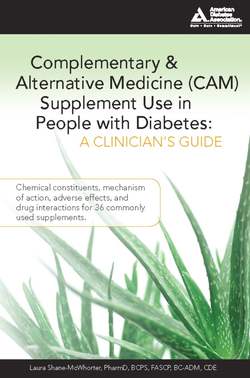Читать книгу Complementary and Alternative Medicine (CAM) Supplement Use in People with Diabetes: A Clinician's Guide - Laura Shane-McWhorter - Страница 8
На сайте Литреса книга снята с продажи.
EPIDEMIOLOGY OF CAM SUPPLEMENT USE
ОглавлениеA landmark study in 1990 indicated that 33.8% of Americans use alternative medicine, although this included a variety of modalities such as acupuncture and chiropractic in addition to oral supplements.6 The study was repeated in 1997, and researchers found that alternative medicine use had increased to 42.1%.12 A finding with important ramifications from the latter survey was that 15 million adults take alternative agents concurrently with prescription drugs. This survey also found that 12.1% of patients take herbal supplements and 5.5% take megavitamins. A 2002 report of medication use in the U.S. indicated that herbals or supplements were used by 14% of the population surveyed.35
Information regarding how many patients with diabetes use CAM supplements has been elucidated by several recent studies. A recent publication reported information regarding CAM supplement use in diabetes patients, using data from the 2002 National Health Interview Survey (NHIS).34 The NHIS included questions regarding CAM use and included data from approximately 2,500 people with diabetes. The researchers determined that 48% of individuals with diabetes reported using some type of CAM therapy, which included many different modalities. Some of these modalities included acupuncture, Ayurveda, biofeedback, chelation, massage, naturopathy, special diets, and herbal therapies. According to the researchers analyzing the NHIS data, 22% of people with diabetes used some type of herbal therapy.
A study using 1996 Medical Expenditure Panel Survey data reported that people with diabetes are 1.6 times more likely than people without diabetes to use CAM (8% vs. 5%, P < 0.0001).10 Nutritional advice and lifestyle diets were the most commonly used therapies. These included Ayurvedic diets, naturopathic or homeopathic nutrition diets, as well as orthomolecular therapies including melatonin, vitamin megadoses, or magnesium administered by CAM practitioners. Other modalities included spiritual healing, herbal remedies, massage therapy, and meditation training.
Other surveys of diabetes clinic patients indicate that 17% to 57% use CAM.36–38 In one study 17% used CAM therapies. Acupuncture, homeopathy, and herbal therapy were used most often.36 Another study found that 31% used dietary supplements.37 The most commonly used supplements were garlic, Echinacea, herbal mixtures, glucosamine, chromium, ginkgo biloba, fish oil, cayenne, and St. John’s wort.37 Data from a national survey of CAM use found that in individuals with diabetes 57% had used CAM treatments in the past year.38 Prayer and spiritual practices, herbal remedies, commercial diets, and folk remedies were reported most often.38 A smaller percentage, 35%, reported use of products specifically for diabetes. Interestingly, patients with diabetes have felt that complementary therapies were useful, but less than their prescription medications.37
CAM therapy use in specific ethnic groups with diabetes has also been reported. In Navajos with diabetes 39% used CAM therapies,39 in Hispanics with diabetes in South Texas 49% used CAM,40 and in a Vietnamese population with diabetes two-thirds used CAM.41 In an evaluation of a small sample of Hispanic diabetes patients, researchers found that most participants were taking both traditional folk remedies and conventional medications.42 Some of the commonly used products included aloe vera (sábila) and prickly pear cactus (nopal).42 Another important finding in this study of Hispanics, with important implications for clinicians, was that many of the participants believed that diabetes may be caused by fright (susto) or anger (coraje) and that insulin may cause blindness and become an addiction. Other surveys of Hispanic patients have found that folk remedies such as herbal teas or other botanical products were used by 33%43 to 64%.15 Unlike studies that have stated that <40% of patients reported use of CAM supplements to their provider,6 studies in Hispanics have found that as many as 69% did not report use of herbal remedies.15 Hence, clinicians should be more proactive in asking their Hispanic patients about CAM supplement use.
CAM supplement use has also been reported across several age groups. One study reported that dietary supplements were used by children with chronic diseases including asthma, cancer, cystic fibrosis, diabetes, hepatic or renal disorders, and rheumatology and neurobehavioral disorders.44 In the children with diabetes, 31% were using a nonprescribed supplement.44 On the opposite end of the age spectrum, a small multiethnic sample of older individuals found that 15% used herbal remedies and 5% used teas to treat their diabetes.45 In female seniors who were members of a health plan, 11% of women with diabetes used herbal products.46
